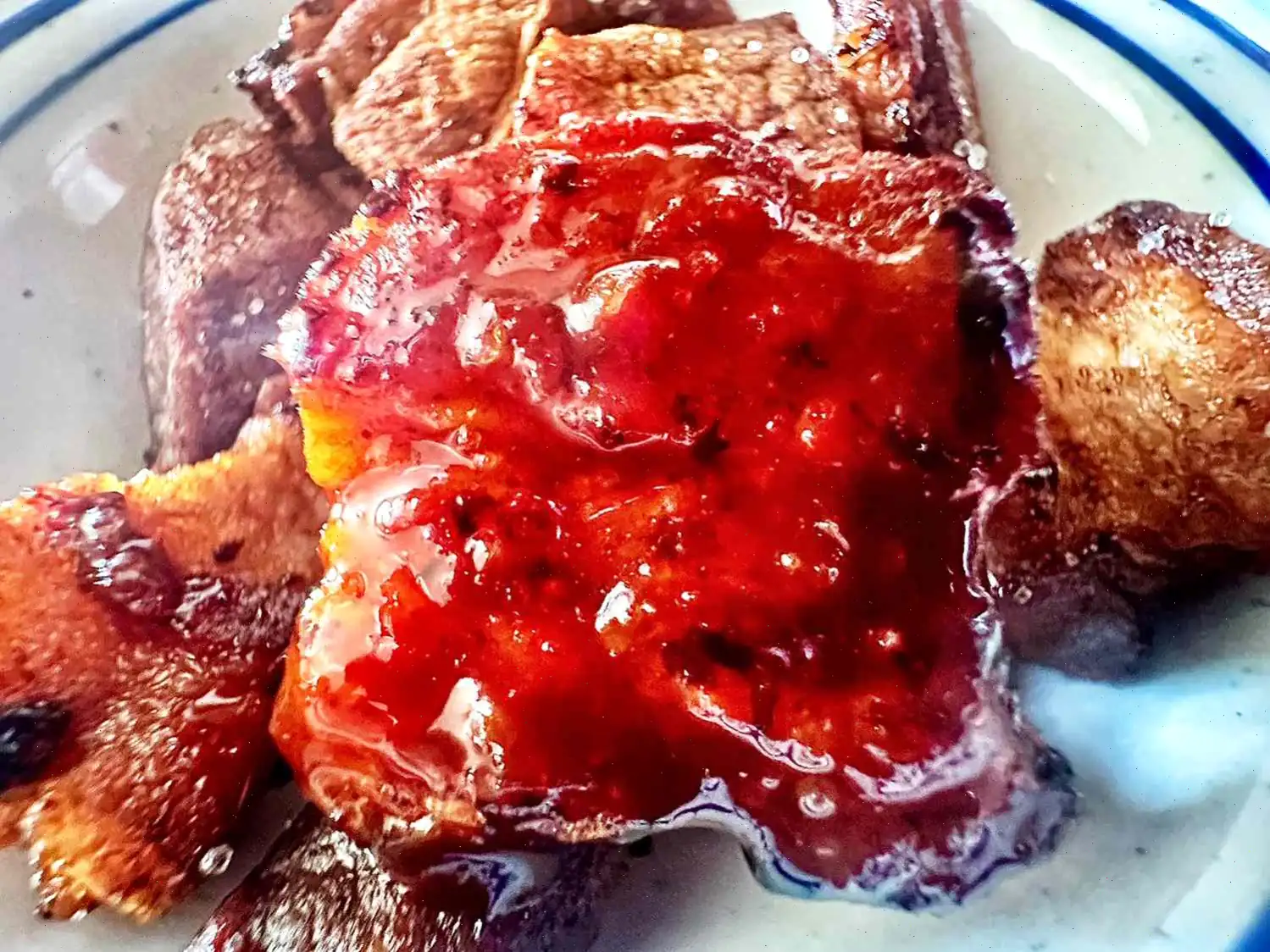
Gochujang Pork Belly Bites Recipe
Original recipe yields 2 servings
Ingredients
- 1 pound pork belly, cut into bite-sized pieces
- 1/4 cup gochujang
- 2 tablespoons soy sauce
- 1 tablespoon hot honey (such as Mike's Hot Honey)
- 1 teaspoon ground ginger
Directions
- Preheat an air fryer to 400F (200C).
- Place pork belly pieces in the air fryer basket in a single layer, ensuring they are not touching.
- Air fry for 8 to 9 minutes. Flip the pieces over and air fry for an additional 6 to 7 minutes.
- While the pork is frying, prepare the sauce by mixing gochujang, soy sauce, hot honey, and ground ginger together in a medium bowl.
- Remove the pork belly from the air fryer and toss it in the prepared sauce to coat evenly.
- Return the pork belly to the air fryer and cook for another 8 to 11 minutes, or until the edges begin to char. (Alternatively, if you prefer, you can use the sauce only for dipping and continue to fry without removing the bites until they start to char, which will take 6 to 7 minutes.)
Nutrition Facts (per serving)
- Calories: 818
- Total Fat: 49g (63% Daily Value)
- Saturated Fat: 18g (89% Daily Value)
- Cholesterol: 191mg (64% Daily Value)
- Sodium: 2882mg (125% Daily Value)
- Total Carbohydrate: 37g (14% Daily Value)
- Dietary Fiber: 1g (2% Daily Value)
- Total Sugars: 28g
- Protein: 55g (110% Daily Value)
- Vitamin C: 6mg (6% Daily Value)
- Calcium: 120mg (9% Daily Value)
- Iron: 3mg (16% Daily Value)
- Potassium: 663mg (14% Daily Value)
* Percent Daily Values are based on a 2,000 calorie diet. Your daily values may be higher or lower depending on your calorie needs.
History and Origin of Gochujang Pork Belly Bites
The roots of Gochujang Pork Belly Bites lie in traditional Korean cuisine, where gochujanga fermented red chili pastehas been a staple for centuries. Originally used to season stews, soups, and side dishes, gochujang brought a unique combination of sweetness, umami, and heat to Korean meals. Pork belly, known for its rich marbling and tender texture, has been a favored cut in Korea for both roasting and braising. The modern adaptation of combining these two ingredients into bite-sized, air-fried pieces represents a fusion of traditional flavors with contemporary cooking techniques, particularly Western methods like air frying that allow for a crispy exterior without deep frying.
Regional Characteristics
This dish reflects a blend of Korean and American culinary styles. In Korea, pork belly is often grilled at the table in Korean barbecue restaurants, served with a variety of sauces and side dishes. Gochujang, being central to Korean seasoning, varies slightly from region to region, with some areas producing sweeter or spicier pastes depending on local preferences. The American influence appears in the use of an air fryer, offering a quicker, convenient method while maintaining the traditional spicy-sweet flavor profile.
How It Differs From Similar Dishes
While Gochujang Pork Belly Bites might remind one of Korean barbecue pork or Korean fried chicken, the key differences lie in preparation and presentation. Unlike grilled pork belly slices, these bites are small, evenly coated, and air-fried for a crisp exterior. Compared to Korean fried chicken, they are less greasy and emphasize the sweet-spicy balance of gochujang rather than heavy battering. This makes them uniquely suited for appetizers or finger foods, highlighting intense flavor in every bite.
Typical Serving Context
These pork belly bites are often served as appetizers or party snacks, particularly in casual dining settings or at home gatherings. In Korean cuisine, small plates like this are commonly paired with rice, kimchi, or wrapped in lettuce leaves for an interactive meal. In a Western context, they frequently appear as bar snacks, tapas-style dishes, or shared plates at restaurants that specialize in fusion cuisine. Their bite-sized format makes them perfect for social dining.
Interesting Facts
- Gochujang is made from fermented soybeans, red chili powder, glutinous rice, and salt, giving it a complex umami flavor that enhances meats remarkably well.
- Pork belly is one of the fattiest cuts of pork, but when properly cooked, it delivers a tender, melt-in-your-mouth texture that pairs beautifully with spicy sauces.
- The popularity of air fryers has transformed traditional Korean dishes, enabling crisp textures without deep frying, which is both healthier and faster.
- In Korea, pork belly is often enjoyed with soju or beer, making these bites an ideal pairing for casual drinks or gatherings.
- Using hot honey in the sauce adds an extra layer of sweet heat, balancing the deep umami of gochujang and creating a flavor profile that appeals to a global audience.








